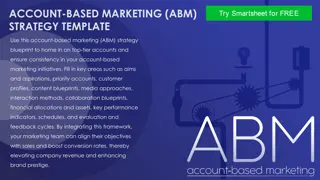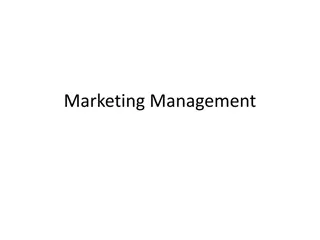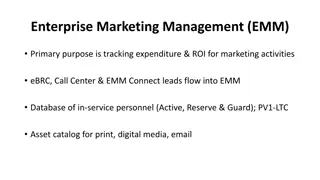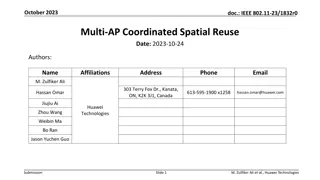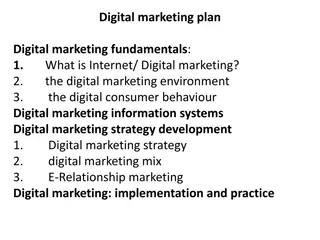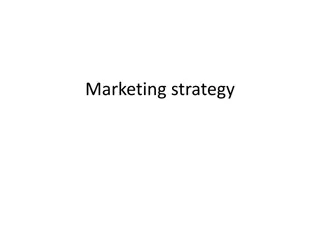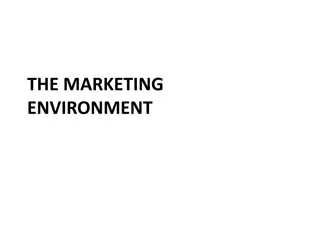Understanding Channel Design in Marketing
Channel design involves planning the distribution of products and services from producers to customers through different business entities or individuals. It encompasses elements like channel flow, channel members, objectives, alternatives, and strategy. Successful channel design aligns with business goals, aims to enhance customer experience, and leverages insights for personalized marketing. Key steps include recognizing the need for channel design decisions, defining channel flow, and setting distribution objectives.
Download Presentation
Please find below an Image/Link to download the presentation.
The content on the website is provided AS IS for your information and personal use only. It may not be sold, licensed, or shared on other websites without obtaining consent from the author. Download presentation by click this link. If you encounter any issues during the download, it is possible that the publisher has removed the file from their server.
Presentation Transcript
Definition: Channel design is a plan for the distribution and movement of products and services from the producer to the customer. A channel is defined as a chain of linked businesses or individuals through which a product or service passes from one person or firm to another. Channel design is also understood as the process involved in the development of new marketing channels that no one had tried before or it can also refer to the strategy of modifying existing channels.
Elements of a Marketing Channel Design 1. Channel Flow Channel flow is the path that products and services take from the producer to the customer. Channel flow is important because it determines how products and services will be delivered to customers. Channel flow also affects the cost of goods and services. Channel flow can be direct or indirect. Direct channel flow is when products and services are delivered to customers without going through any intermediaries. Indirect channel flow is when products and services are delivered to customers through intermediaries such as retailers or distributors. 2. Channel Members Channel members are the businesses or individuals who are involved in the distribution of products and services. A channel member can be categorized as upstream or downstream. Upstream channel members are businesses or individuals who are involved in the production of goods and services. Downstream channel members are businesses or individuals who are involved in the marketing and sale of goods and services.
3. Channel Objectives Channel objectives are the goals that a company wants to achieve through its marketing channels. Marketing channel objectives can include increasing sales, reaching new customers, and improving customer service. 4. Channel Alternatives Channel alternatives are the different ways that a company can distribute its products and services. Major channel alternatives can include direct marketing, selective distribution, and exclusive distribution. While identifying major alternatives, it is important to recognize that the most effective Channel Strategy rests on a Channel design that Is customer-focused Delivers a superior customer experience Provides an integrated customer view Uses Channel Insights to enable 1:1 marketing Builds relationships through loyalty programs
5. Channel Strategy Channel strategy is the overall plan that a company uses to determine which marketing channels to use. Channel strategy should be aligned with business objectives while designing marketing channels. Steps involved in Channel Design 1. Recognizing the need for a channel design decision Channel design decisions need to be made when there is a change in the business environment or when a company wants to enter a new market. 2. Defining the Channel Flow The first step in channel design is to define the channel flow. Channel flow is the path that products and services take from the producer to the customer. Channel flow can be direct or indirect. 3. Setting and coordinating distribution objectives Channel objectives should be aligned with business objectives. Channel objectives can include increasing sales, reaching new customers, and improving customer service.
4. Specifying the distribution tasks The next step in channel design is to specify the distribution tasks. Distribution tasks are the activities that need to be performed in order to deliver products and services. 5. Developing possible alternative channel structures Channel alternatives are the different ways that a company can distribute its products and services. Channel alternatives can include direct marketing, selective distribution, and exclusive distribution. 6. Evaluating the variable affecting channel structure There are several variables that can affect channel structure. These variables include the type of product, the target market, and the distribution channels that are available. 7. Selecting the final channel structure The final step in channel design is to select the final channel structure. The Channel structure should be aligned with business objectives. Channel structure can be direct or indirect.
8. Selecting the channel members Channel members are the businesses or individuals who are involved in the distribution of products and services. Channel members can be categorized as upstream or downstream. 9. Implementing and coordinating the channel structure The final step in channel design is to implement and coordinate the channel structure. Variables that affect Channel Structure 1. Product Variables The type of product can affect channel structure. Different product variables include bulk and weight, unit value, perishability, technical versus nontechnical, newness, etc. 2. Market Variables The target market can also affect channel structure. Some markets require a direct channel, while others can be reached through an indirect channel. Common market variables are market geography, market density, market size, and market behavior.
3. Company Variables The size of the company can also affect channel structure. Some companies are too small to support a direct channel, while others may not have the resources to support an indirect channel. Common company variables are size, managerial expertise, financial capacity, and objectives and strategies. 4. Intermediary Variables The type of intermediary can also affect channel structure. Some intermediaries are more willing to work with a direct channel, while others may prefer an indirect channel. The key intermediary variables related here are availability, services offered, and costs. 5. Environmental Variables The final variable that can affect channel structure is the environment. The environment includes factors such as government regulations, social trends, and economic conditions. Channel structure should be designed to respond to environmental changes.
Types of Channel Structures 1. Direct Channel A direct channel is a channel in which the producer sells directly to the customer. Direct channels can be used to reach large markets quickly. The disadvantage of a direct channel is that it can be costly to set up and maintain. 2. Indirect Channel An indirect channel is a channel in which the producer sells through an intermediary. Indirect channels can be used to reach small markets quickly. The disadvantage of an indirect channel is that it can be difficult to control. Channel members 1. Upstream Channel Members Upstream channel members are businesses or individuals who are involved in the production of products and services. Upstream channel members can include suppliers, manufacturers, and wholesalers. 2. Downstream Channel Members Downstream channel members are businesses or individuals who are involved in the distribution of products and services. Downstream channel members can include retailers, distributors, and dealers.
Factors to Consider When Selecting Channel Members 1. Compatibility The channel members should be compatible with each other. They should have similar business philosophies and be able to work together to achieve the objectives of the channel. 2. Capability The channel members should have the capability to perform their roles in the channel. They should have the necessary resources and skills to support the channel. 3. Commitment The channel members should be committed to the success of the channel. They should be willing to invest the time and resources necessary to support the channel. 4. Cooperation The channel members should be willing to cooperate with each other. They should be able to work together to achieve the objectives of the channel.
5. Communication The channel members should be able to communicate with each other. They should be able to share information and ideas in a way that is clear and concise. 6. Coordination The channel members should be able to coordinate their activities. They should be able to work together to achieve the objectives of the channel. Approaches you may use to choose the Best Channel Structure: 1. Characteristics of Goods and Parallel Systems Approach According to this approach, the decision on which type of channel structure to use is based on the characteristics of the goods. The Aspinwall model was first developed in the 1950s by Aspinwall. The main consideration for channel structure selection should be product variables, according to this design. Each item characteristic is labeled with a distinct hue on the spectrum. Different variables involved in this are replacement rate, adjustment, gross margin, time of consumption, searching time, etc.
2. Financial Approach The financial approach is based on the idea that the best channel structure is the one that minimizes costs and maximizes profits. Channel structures should be evaluated based on their ability to generate revenue and control costs. 3. Transaction Cost Analysis (TCA) Approach The transaction cost analysis approach is based on the idea that the best channel structure is the one that minimizes transaction costs. Transaction costs can include search costs, information costs, negotiation costs, and monitoring costs. The crux of TCA is on the expenditures incurred by a corporation in order to complete its distribution operations. 4. Management Science Approaches Management science approaches to channel structure selection are based on the idea that the best channel structure is the one that maximizes efficiency. Channel structures should be evaluated based on their ability to optimize resources and minimize waste.
5. Marketing Mix Approach The marketing mix approach is based on the idea that the best channel structure is the one that maximizes the effectiveness of the marketing mix. Channel structures should be evaluated based on their ability to reach the target market, communicate with the target market, and sell to the target market. 6. Judgmental-Heuristic Approaches Judgmental-heuristic approaches to channel structure selection are based on the idea that the best channel structure is the one that best meets the needs of the company. Channel structures should be evaluated based on their ability to support the company s business objectives.








